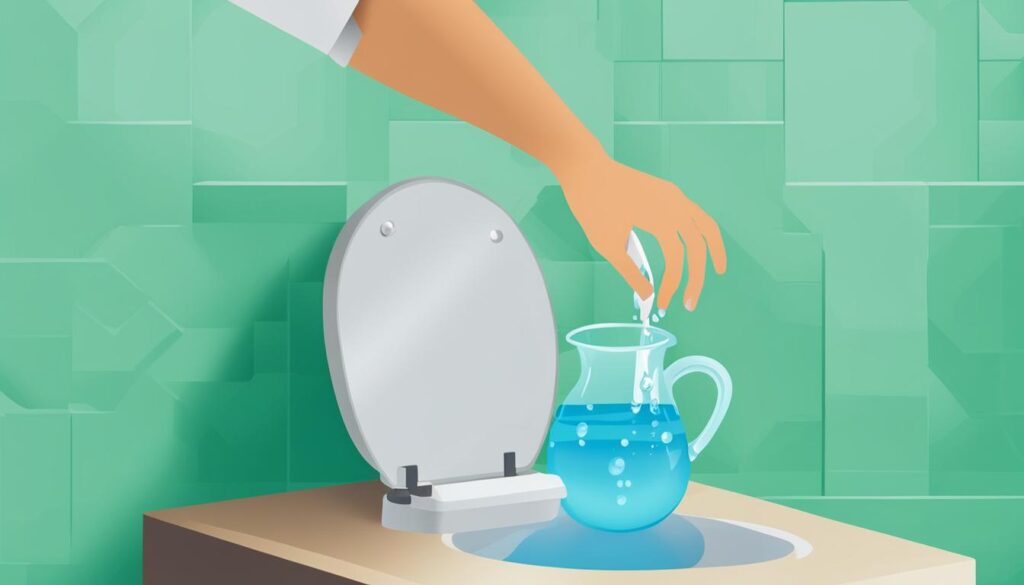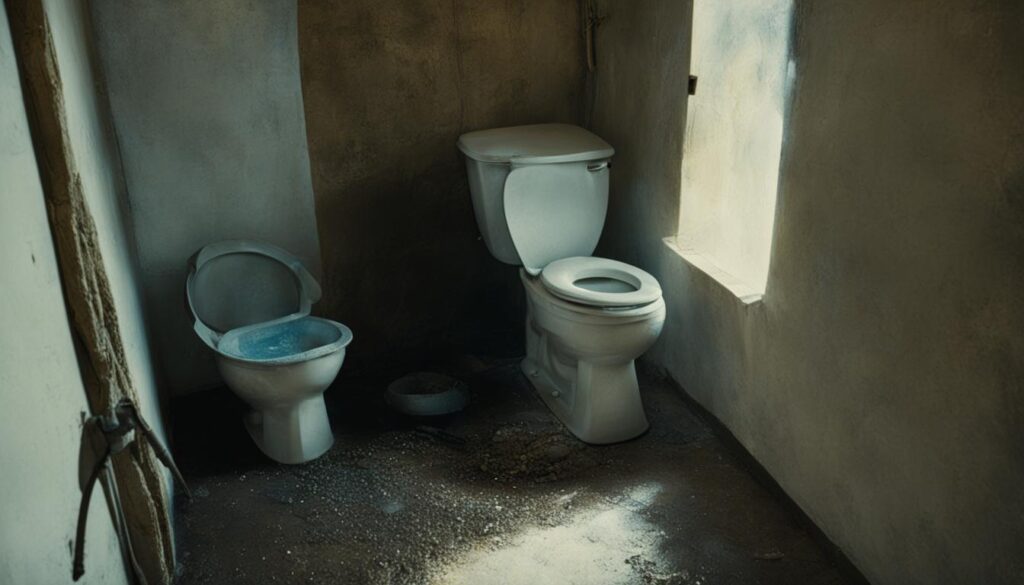When your toilet won’t flush due to a clog, low water level, a malfunctioning lift chain, or a faulty rubber flapper, it’s important to know how to manually flush it without running water. There are three effective methods you can try: pouring a bucket of water into the toilet bowl, pouring water directly into the toilet tank, and manually pulling the rubber flapper in the toilet tank. These methods can help you resolve flushing issues and keep your bathroom functioning even when the water supply is turned off.
How to Flush a Toilet Without Running Water
- When your toilet won’t flush, you can manually flush it without running water using different methods.
- Pouring a bucket of water into the toilet bowl is a simple and effective way to create enough pressure for a flush.
- Pouring water directly into the toilet tank can help if the problem lies within the tank.
- Manually pulling the rubber flapper in the toilet tank can also trigger a flush.
- Exploring alternative flushing methods like waterless toilets can provide eco-friendly options.
Method 1 – Throw a Bucket of Water into the Toilet Bowl
Pouring a bucket of water into the toilet bowl is a simple and eco-friendly method to flush your toilet without running water. This method is perfect for situations where the water supply is turned off or during water shutdowns. It requires only a bucket filled with water, making it a convenient DIY solution.
How to Flush a Toilet Using a Bucket of Water
To flush your toilet using this method, you’ll need a bucket filled with at least one gallon of water. Slowly pour the water into the toilet bowl, gradually increasing the speed until the bowl is full. Then, quickly dump the rest of the water into the bowl. The force of the water creates enough pressure to push waste through the pipes and flush the toilet.
This waterless toilet flushing technique not only helps conserve water but also ensures that your bathroom remains functional even without running water. It’s a practical solution that you can rely on during emergencies or temporary disruptions in the water supply.
Using a bucket of water to flush your toilet is an eco-friendly alternative that can come in handy in various situations. Whether you’re camping, experiencing a water shortage, or simply prefer a sustainable approach to toilet flushing, this method is a valuable DIY solution.
Method 2 – Pour Water Into the Toilet Tank
If your toilet isn’t flushing due to a problem inside the tank, there is an alternative method you can try. By pouring water directly into the toilet tank, you may be able to manually flush the toilet without running water.
To begin, remove the tank cover to access the inside of the tank. Take note of the water line or the fill line inside the tank, as you will need to fill the tank up to this point. Using a container, carefully pour water into the tank, making sure not to overflow it. The amount of water you will need depends on the specific model of your toilet, so it is best to consult the manufacturer’s instructions if available.
Once you have poured the water, try pressing the flush lever to activate the flushing mechanism. If your toilet still does not flush, there may be additional issues that need to be addressed, such as a faulty flapper or a problem with the handle mechanism. In such cases, it is recommended to seek professional assistance from a plumber.
Water Conservation Techniques for Toilet Flushing
Flushing toilets using alternative methods like pouring water into the tank can help conserve water in situations where the water supply is limited or temporarily unavailable. By manually flushing the toilet with a controlled amount of water, you can avoid excessive water usage and contribute to sustainable practices.

Additionally, it is worth exploring other water-saving techniques to minimize your overall water consumption in the bathroom. Installing a dual-flush toilet, which offers different flushing options for liquid and solid waste, can significantly reduce water usage. Another option is to retrofit your existing toilet with a flush converter kit, which allows you to adjust the water volume for each flush.
By adopting these water conservation techniques, you can contribute to preserving our precious water resources and promote sustainable toilet flushing practices.
Method 3 – Pull the Rubber Flapper in the Toilet Tank
When faced with a toilet that won’t flush, one possible culprit is a malfunctioning rubber flapper in the toilet tank. If pressing the handle doesn’t cause a flush, there’s no need to panic. There’s a simple DIY method you can try to manually flush the toilet without running water.
To begin, remove the tank lid and inspect if the chain connecting the handle arm to the flapper is intact. If it’s disconnected, simply reconnect it and try pressing the handle again. In many cases, this will solve the flushing issue and restore the toilet’s functionality.
If reconnecting the chain doesn’t resolve the problem, check to see if the rubber flapper is properly seated over the opening at the bottom of the tank. If it’s not positioned correctly, carefully re-seat the flapper and ensure that the chain is connected securely. After this adjustment, try pressing the handle once more to see if the toilet flushes properly.
In the event that the previous steps haven’t resolved the flushing problem, it may be necessary to replace the rubber flapper. Consult a professional plumber for assistance or refer to instructional videos and guides available online to ensure proper installation.
Alternative Flushing Methods During Water Shutdowns
In situations where there is a water shutdown or limited access to running water, there are alternative methods to flush a toilet. One option is to use a bucket of water to pour directly into the toilet bowl, creating enough pressure to flush it. This method is simple and effective, requiring only a bucket filled with water. Slowly pour the water into the bowl, increasing the speed gradually, until the bowl is full and then dump the rest of the water. The water should create enough pressure to push waste through the pipes and flush the toilet.
Another method to consider is using waterless toilet flushing products. These eco-friendly options do not require running water for flushing and can be a sustainable solution during water shutdowns. One example is a composting toilet, which uses natural processes to break down waste into compost. This not only eliminates the need for water but also creates nutrient-rich soil. Portable camping toilets are also available, allowing you to have a toilet system that can be used without running water.
By exploring these alternative flushing methods, you can overcome flushing issues during water shutdowns without relying on traditional water-dependent systems. Not only are these methods environmentally friendly, but they also provide a practical solution for situations where running water is unavailable or limited. Remember to assess your specific needs and choose the method that works best for you.
Conclusion
Learning how to flush a toilet without running water is an essential skill, especially during emergencies or water shutdowns. By utilizing the three methods explained – pouring a bucket of water into the toilet bowl, pouring water into the toilet tank, and manually pulling the rubber flapper – you can effectively resolve flushing issues and ensure your bathroom remains functional.
Remember, these non-traditional toilet flushing methods are helpful in temporary situations, but if problems persist, it’s important to contact a professional plumber. They can address any underlying issues that may be causing the toilet to not flush properly.
Furthermore, exploring alternative flushing methods such as waterless toilets can provide long-term solutions that are sustainable and eco-friendly. These options, like composting toilets or portable camping toilets, don’t require running water for flushing and can be a great alternative for those passionate about conserving water resources.
By familiarizing yourself with different toilet flushing techniques and considering alternative options, you can maintain a functioning bathroom even without running water. So, remember to stay prepared and take the necessary steps to ensure your toilet remains operational during any water-related challenges.
FAQ
Can I flush a toilet without running water?
Yes, there are several methods you can try to manually flush a toilet without running water.
How can I flush a toilet without running water?
There are three effective methods you can try: pouring a bucket of water into the toilet bowl, pouring water directly into the toilet tank, and manually pulling the rubber flapper in the toilet tank.
How much water do I need to pour into the toilet bowl?
You’ll need at least one gallon of water, though older toilets may require 3-5 gallons of water. Slowly pour the water into the bowl, gradually increasing the speed, until the bowl is full and then dump the rest of the water.
How do I pour water into the toilet tank?
Start by removing the tank cover and fill the tank up to the water line or one inch below the edge. The amount of water needed will depend on the toilet model. After pouring the water, try pressing the flush lever.
What should I do if pulling the rubber flapper doesn’t work?
First, check if the chain is connected to the handle arm. If it’s disconnected, reconnect it and try pressing the handle again. If that doesn’t work, ensure the flapper is properly seated over the opening at the bottom of the tank. Re-seat it if necessary and check if the chain is connected to the flapper. If all else fails, the flapper may need to be replaced.
Are there alternative methods to flush a toilet during water shutdowns?
Yes, one option is to use a bucket of water to pour directly into the toilet bowl, creating enough pressure to flush it. Another method is to use waterless toilet flushing products, such as composting toilets or portable camping toilets.

